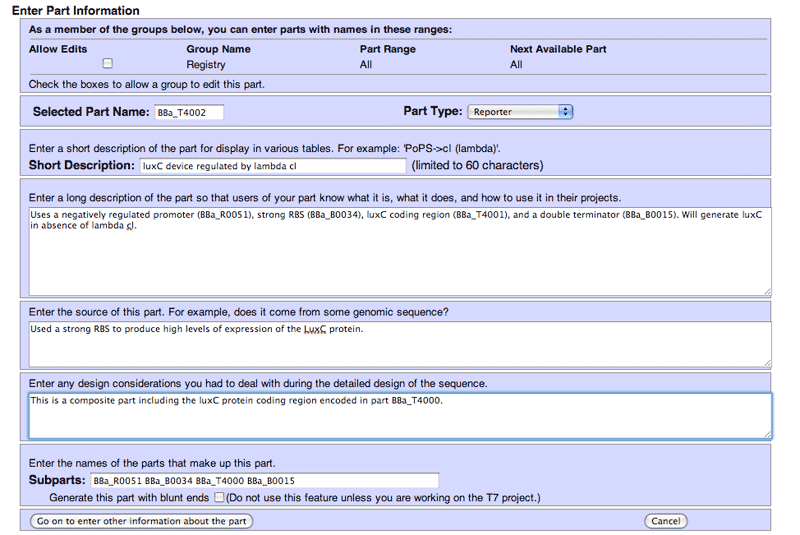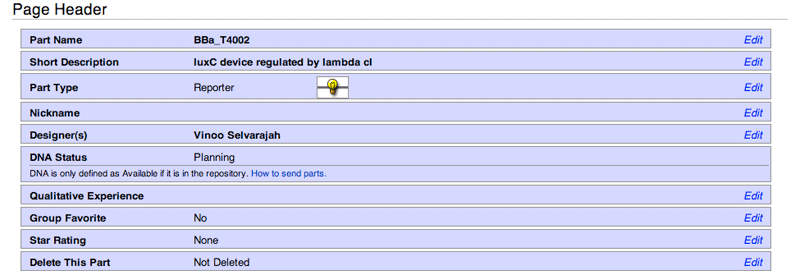Help:Adding Parts/Composite
- Registry Help Pages:
- TOC
- At-a-Glance
- FAQ
Add a Part to the Registry: Related Registry Help Pages
- Add a Basic Part - A tutorial on how to add a basic part
- Add a Composite Part - A tutorial on how to add a composite part
- Scars - Information on assembly scars, and how to specify them for a composite part
- Synthesis - Things to keep in mind if you're adding and documenting a part you've synthesized
- Assembly Compatibility - Make sure your part is compatible with an assembly standard
- Twins - Parts are twins if they have the same sequence
- Document Parts - Recommendations on how to document your parts
- Make a Contribution - Improve existing parts
Have questions on adding a part to the Registry? Send an email to hq (at) igem . org.
Add a Composite Part
You've thought of a new composite part, but before you assemble a sample in the lab, you should add the composite part to the Registry. The following help page will help you through the process of adding a new composite part to the Registry. The information that you enter here will populate your part's Main page and sub-pages. If you want to add a basic part, see here.
Users can add parts to the Registry that adhere to other assembly standards, however BioBrick RFC[10] and Type IIS are the Registry's current de facto standards; all parts on the Registry that will be considered for the iGEM competition (medals, awards, etc.) must be assembly compatible for BioBrick or Type IIS.
Start adding your part:
- hover over Tools in the Registry menu above.
- click on the Add a Part link
- click on Add a Composite Part Now...
This will let you enter the Part Name & Information.
For the following example, we will be making a composite part (BBa_T4002) using our previously made basic part (BBa_T4000) as one of its components. You will find that the process for adding a composite part is very similar to a basic part, if you've already made one.
Part Name & Information
- Group - Select the group(s) that you would like to have permission to edit your part. By default you need to select the group you are submitting the part on behalf of, but you may find that you belong to multiple groups: iGEM team(s), labs, or courses. The group section will also show you the associated part range for the group(s) you belong to.
- Selected Part Name - Enter a part name within your assigned part range. The part name should not already be used within the Registry. If it is, the form will state that The part already exists. Please try again. when you attempt to submit the part.
- Part Type - Choose the part type of your part. You will able to change this by going to your part's Hard Information page.
- Ex. Part Type is Reporter since the part will be a device, regulated by lambda cl, that generates luxC protein.
- Short Description - Enter the short description. This usually is the biological or technical short hand for the part's function. You will able to change this by going to your part's Hard Information page.
- Ex. Short Description is luxC device regulated by lambda cl
- Long Description - Enter in a detailed description of your part, its functions, and its requirements. The long description will show up on the part's Main Page, and can be changed from there.
- Ex. Long Description will explain the part's function for now. As the part is tested and used, more information can be added here.
- Source of this part - Enter the source of this part. You will able to change this by going to your part's Design page.
- Ex. The source of the part will be its components.
- Design Considerations - Enter in any considerations you may have taken for the part (mutations to remove restriction sites, codon optimization, etc) You will able to change this by going to your part's Design page.
- Ex. Used a strong RBS to produce high levels of expression of the luxC protein.
- Subparts - Now you can add in the basic or composite parts that form your part. Enter the first part name followed by a space, the second, and so on. Important: The Registry will use this information to put your part's sequence together, including the scars that would appear during assembly. If you used a scarless assembly method, the scars can be changed at a later point.
- Go on to enter other information about this part - Click this to have your composite part added to the Registry, but you're not done yet!
Sequence and Features
After adding your composite part, you may need to make changes to its composition, either the subparts or the scars between them.
On the part tools menu, you can find the Edit sequence and features page. Clicking on Edit will allow you to change the subparts that make up your composite part.
Change your part's composition
- Click on Edit
- Make changes (additions or edits to the subpart list)
- and Save!
Unlike basic parts, you cannot enter a sequence for a composite part. The Registry uses the subparts declared to put your part's sequence together, including the scars (in bracket notation) that would appear during assembly. Please see our page on assembly scars for more information.
Additionally the composite part will not have a features box, to add or change features, as it will inherit all features/annotations from its subparts.
You can always return to this page by going to part tools > Edit Sequence and Features.
Hard Information Page
The Hard Information page has some of the parameters for the part that classify and organize it within the Registry's database, this includes some of the details from the adding a part page.
Page Header
- Part Name - The official name of the part.
- Short Description - The short description is usually a biological or technical descriptor of the part.
- Part Type - This will state the part type, and will show up at the top of the part page, to the left of the DNA Status.
- Nickname - The nickname of a part. This will show up at the top of the part page, right below the part type and to the left of the DNA Status.
- Designer(s) - By default the Registry will add the name of the user who added the part. However more designers can be added.
- DNA Status - States the DNA status of your part: Deleted, Planning, Sent, Available, etc. These statuses are generated by the Registry, so the user cannot edit them.
- Qualitative Experience - States whether you have tested your part and if it works.
- Group Favorite - You can choose if the part is a favorite of your team/group.
- Star Rating - Decided by the Registry
- Delete This Part - You can delete this part.
Part Parameters
The footer section allows for the setting of part parameters, allowing for a degree of technical specification for the part. Parameters are user added and specified.
BBa_T4002 is a device generating luxC which will be regulated by lambda cl and used in E. coli. In this example, we've used the parameters to reflect these specifications
- chassis - E. coli
- negative_regulators - lambda cl
- Add another parameter - Add another parameter to the part. For example, we could add another parameter, that would state that BBa_T4002's product is luxC.
Part Categories
Categories allow for a part to become content in automatically generated part tables, which is important in defining the organization of your part within the Registry, and specifically for the Catalog of Parts and Devices.
We've declared a few categories which will allow BBa_T4002 to be organized properly in the Registry
- //chassis/prokaryote/ecoli - We will be using and testing the device in E. coli
- //classic/reporter - BBa_T4002 is a reporter device




